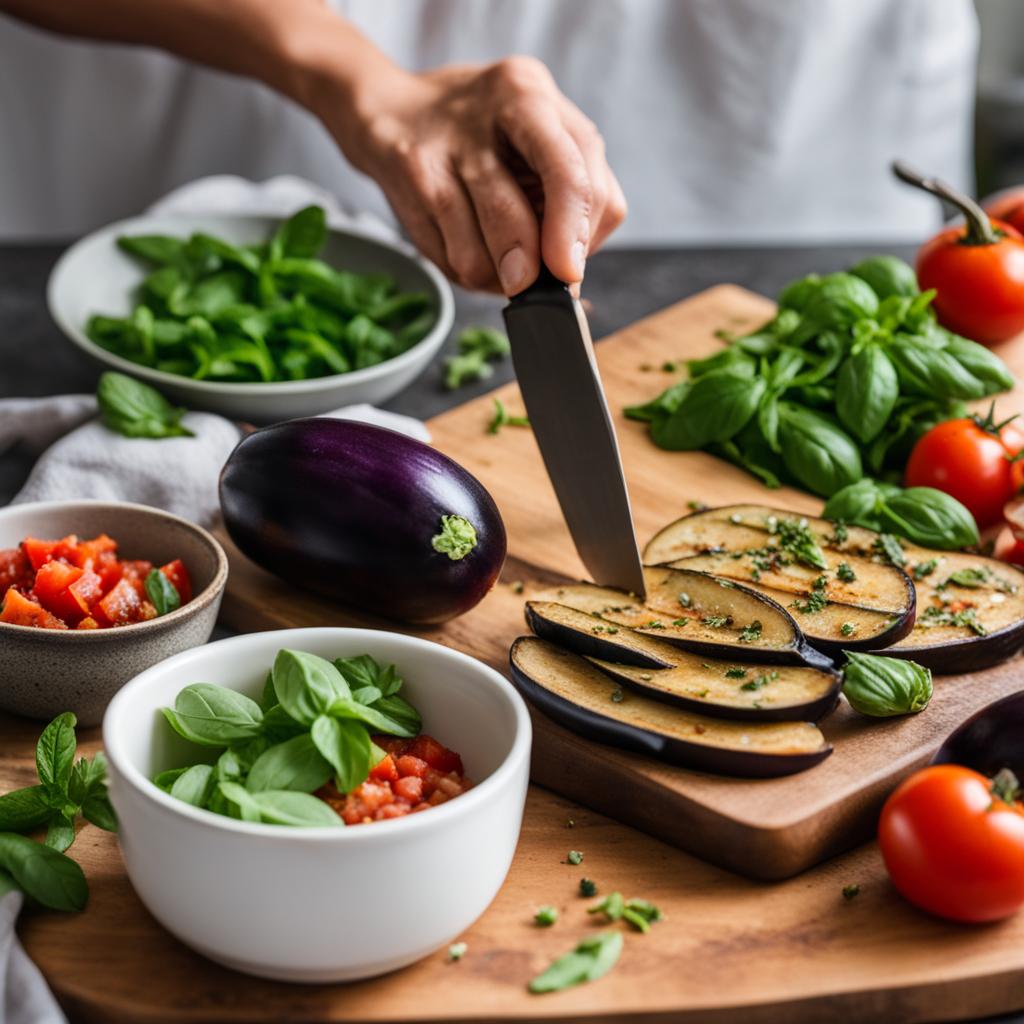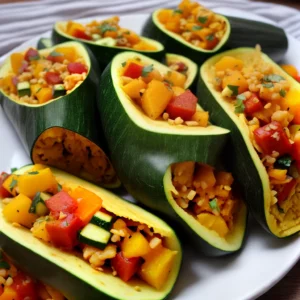Sharpen your knife skills as you learn to cut eggplant in three different ways. Eggplant appears in many Mediterranean recipes, making it a versatile vegetable for vegan and vegetarian dishes. Eggplant is rich in iron, calcium, fiber, and vitamins. Before cutting the eggplant, decide whether to peel it based on the recipe. Thicker slices allow for a creamier texture. Choose a fresh eggplant with shiny purple skin and no bruises. Use a sharp knife for precise cuts, and preserve the slices by brushing them with lemon juice to prevent browning.
Key Takeaways:
- Cutting eggplant in various ways adds versatility to your dishes
- Eggplant is a nutritious vegetable rich in iron, calcium, fiber, and vitamins
- Consider peeling the eggplant based on the recipe and desired texture
- Choose a fresh eggplant with shiny purple skin and no bruises
- Brushing lemon juice on the slices helps prevent browning
Different Methods of Cutting Eggplant
When it comes to cutting eggplant, there are three popular methods you can use: slicing, dicing, and chopping. Each method offers its own unique texture and shape, making it suitable for various culinary creations.
If you prefer to have thin, uniform slices of eggplant, slicing is your best bet. Simply lay the eggplant on its side and make 1/2″ slices across the vegetable. This method is great for roasting or grilling, as it allows the eggplant to cook evenly.
For smaller, bite-sized pieces, dicing is the way to go. Start by slicing the eggplant into sticks, and then cut those sticks into your desired cube size. This method is commonly used in stir-fries and curry recipes, as it allows for even cooking and a cohesive dish.
Lastly, chopping the eggplant into cubes offers versatility and is suitable for a wider range of dishes. You can use the cubed eggplant in stews, soups, casseroles, and more. This method provides a heartier texture and allows the eggplant to hold its shape during cooking.
Methods of Cutting Eggplant:
| Method | Description | Suitable Dishes |
|---|---|---|
| Slicing | Lay the eggplant on its side and make 1/2″ slices across the vegetable | Roasted or grilled eggplant |
| Dicing | Slice the eggplant into sticks and then cut into desired cube size | Stir-fries, curries |
| Chopping | Cut the eggplant into cubes | Stews, soups, casseroles |
Tips for Cutting Eggplant
When it comes to cutting eggplant, there are a few tips and tricks that can make the process easier and more efficient. Whether you’re a beginner in the kitchen or a seasoned chef, these tips will help you achieve perfect slices every time.
First and foremost, start with a fresh eggplant that has a shiny purple skin and feels heavy for its size. This ensures that you’re working with a high-quality vegetable that will yield the best results. It’s also important to use a sharp knife for easier and more precise cuts. A dull knife can make the process more difficult and may result in uneven slices.
If you’re worried about the eggplant slices browning before you’re ready to cook them, brush them with lemon juice. Lemon juice acts as a natural preservative and prevents oxidation, keeping your eggplant looking fresh and appetizing. Additionally, salting the eggplant before cooking can reduce its ability to absorb fat and grease, resulting in a healthier dish.
Lastly, when storing cut eggplant, it’s important to keep it in an airtight container in the fridge. This will extend its shelf life and help maintain its freshness. Don’t forget to brush the slices with lemon juice before storing to further prevent browning. With these tips in mind, you’ll be well-equipped to tackle any eggplant recipe with confidence and ease.
| Tip | Description |
|---|---|
| Choose a fresh eggplant | Select an eggplant with shiny purple skin and no bruises for the best results. |
| Use a sharp knife | A sharp knife will make cutting eggplant easier and more precise. |
| Brush slices with lemon juice | Prevent browning by brushing the eggplant slices with lemon juice. |
| Salt the eggplant before cooking | Reduce the eggplant’s ability to absorb fat and grease by salting it before cooking. |
| Store cut eggplant in an airtight container | Extend the shelf life of cut eggplant by storing it in an airtight container in the fridge. |
Techniques for Cutting Eggplant
When it comes to cooking with eggplant, mastering the art of cutting is essential. The way you slice, dice, or chop the eggplant can greatly impact the texture and flavor of your dishes. In this section, I will guide you through various techniques for cutting eggplant, allowing you to choose the right method based on your recipe and desired outcome.
One popular technique for cutting eggplant is slicing it into rounds. This method is perfect for roasting or grilling the eggplant, as it allows for even cooking and a beautiful presentation. To achieve uniform slices, use a sharp knife and aim for slices that are approximately 1/2 inch thick.
If you’re looking to incorporate eggplant into stir-fries or curry recipes, dicing is the way to go. Diced eggplant cooks quickly and evenly, blending seamlessly with other ingredients. Start by slicing the eggplant into sticks, then proceed to cut those sticks into your desired cube size.
If versatility is what you’re after, chopping the eggplant into cubes is your best bet. Cubed eggplant can be used in a wide range of dishes, such as stews, casseroles, and pasta sauces. Simply slice the eggplant into sticks, then cut those sticks into cubes.
By familiarizing yourself with these cutting techniques, you’ll be able to explore a multitude of recipes that feature eggplant as a star ingredient. Whether you’re slicing, dicing, or chopping, the right technique will ensure that your eggplant dishes turn out flavorful and visually appealing.
Comparison of Cutting Techniques
| Technique | Best For | Texture | Recipe Examples |
|---|---|---|---|
| Slicing | Roasting, Grilling | Tender, Creamy | Eggplant Parmesan, Grilled Eggplant Sandwiches |
| Dicing | Stir-Fries, Curries | Tender, Blendable | Eggplant Stir-Fry, Eggplant Curry |
| Chopping | Stews, Casseroles | Versatile | Eggplant Ratatouille, Eggplant Pasta Sauce |
Do You Peel Eggplant?
When it comes to preparing eggplant for your vegetable dishes, the question of whether to peel the eggplant can arise. The decision to peel or not to peel depends on personal preference and the specific recipe you are following. The skin of the eggplant is edible and adds texture to dishes, but some recipes may call for peeled eggplant.
If you choose to peel the eggplant, you can use a vegetable peeler or a knife to remove the skin before cutting it. Take care to remove only the skin and not too much of the flesh of the eggplant. Once peeled, you can proceed with cutting the eggplant according to the recipe’s instructions. Remember to handle the knife with caution and use a cutting board for stability.
“The decision to peel or not to peel eggplant depends on personal preference and the specific recipe you are following.”
It’s important to consider the specific recipe and your own taste preferences when deciding whether to peel the eggplant. Some dishes may benefit from the added texture and flavor that the skin provides, while others may require a smoother texture without the skin. By understanding the requirements of your recipe and your personal preferences, you can make an informed decision about peeling the eggplant.
Table: Pros and Cons of Peeling Eggplant
| Pros | Cons |
|---|---|
| Texture and flavor enhancement | Some recipes may require peeled eggplant |
| Added nutrients from the skin | Peeling can be time-consuming |
| Easy digestion with peeled eggplant | Removal of beneficial antioxidants in the skin |
Culinary Skills: Exploring the Potential of Eggplant Seeds
When it comes to cooking with eggplant, the focus is often on the vibrant purple skin and creamy flesh. However, the seeds of this versatile vegetable should not be overlooked. Not only are eggplant seeds safe to eat, but they can also add a unique texture and flavor to your dishes. Whether you choose to embrace their presence or remove them is entirely up to your personal preference and the specific recipe you’re following.
Younger eggplants tend to have fewer and lighter-tasting seeds, making them more enjoyable to consume. On the other hand, more mature eggplants can have darker and slightly bitter seeds. If you’re looking for a smoother texture in your dish, you can easily remove the seeds by gently scooping them out with a spoon. However, if you appreciate the added crunch and earthy flavor they provide, feel free to include them in your culinary creations.
Eggplant seeds can add a delightful crunch and earthy flavor to your dishes. They are safe to eat and can be enjoyed in various recipes. Experiment with different cooking techniques to discover the unique taste and texture they bring to your meals.
When incorporating eggplant seeds into your recipes, consider their taste and texture. Roasting or toasting them lightly can enhance their nutty flavor and make them even more enjoyable. You can use them as a garnish for salads or soups, incorporate them into bread or muffin recipes, or experiment with grinding them into a flavorful seasoning. The possibilities are endless, and by embracing the culinary potential of eggplant seeds, you can elevate your dishes to new heights.

Discovering New Flavors with Eggplant Seeds
As you explore the world of eggplant seeds, don’t be afraid to let your culinary creativity shine. Try adding them to roasted vegetable medleys for an extra burst of flavor, or sprinkle them on top of homemade pizzas for a satisfying crunch. You can also use them as a nutritious and flavorful addition to your morning smoothies or granola bowls. With their unique taste and texture, eggplant seeds are a hidden gem waiting to be discovered in your kitchen.
| Recipe Ideas | Cooking Tricks |
|---|---|
| Create a delicious eggplant dip by blending roasted eggplant seeds with tahini, lemon juice, and garlic. | For a milder flavor, soak the eggplant seeds in water for a few hours before using them in your recipes. |
| Add a handful of toasted eggplant seeds to your favorite trail mix for an extra burst of protein and crunch. | Experiment with different spices and seasonings to enhance the flavor of the eggplant seeds in your dishes. |
| Use ground eggplant seeds as a coating for baked chicken or fish to add a unique twist to your favorite dishes. | When roasting eggplant seeds, keep a close eye on them to prevent burning and maintain their delicate flavor. |
By embracing the culinary potential of eggplant seeds, you can unlock a whole new world of flavors and textures in your cooking. Whether you decide to include them whole, remove them, or experiment with different cooking techniques, these tiny seeds have the power to transform your dishes into culinary masterpieces. So go ahead, take a leap of culinary faith, and let the humble eggplant seed take center stage in your kitchen.
Tips for Storing Cut Eggplant
Properly storing cut eggplant is essential to maintain its freshness and quality. Follow these tips to ensure your cut eggplant stays fresh for longer:
1. Airtight Container
Store cut eggplant in an airtight container to prevent air exposure and moisture loss. This helps preserve its texture and flavor. Make sure the container is clean and dry before storing the eggplant slices.
2. Brush with Lemon Juice
Brushing the cut eggplant slices with lemon juice is a great way to slow down the browning process. Lemon juice acts as a natural antioxidant, preventing the slices from oxidizing and turning brown. It also adds a hint of citrus flavor to the eggplant.
3. Refrigerate
Place the airtight container with the cut eggplant slices in the refrigerator. The cool temperature of the fridge helps to inhibit the growth of bacteria and prolong the shelf life of the eggplant. Stored properly, cut eggplant can last up to one week.
4. Freezing
If you want to extend the storage time of cut eggplant, you can freeze it. Before freezing, blanch the eggplant slices by briefly immersing them in boiling water for a few minutes and then transferring them to an ice bath. This helps to maintain the quality and texture of the eggplant. Once blanched, pat the slices dry and place them in freezer-safe bags or containers. Thaw the frozen eggplant completely before using it in your recipes.
By following these tips, you can store your cut eggplant effectively and enjoy its freshness and flavor in your meals even after several days.
Must-Have Kitchen Tools for Cutting Eggplant
When it comes to cutting eggplant, having the right kitchen tools can make all the difference. Here are some essential items that will make your eggplant preparation process easier and more efficient:
- A sharp chef’s knife: A sharp knife is crucial for precise cuts. It allows you to effortlessly slice through the eggplant without crushing or tearing the flesh.
- A non-slip cutting board: To ensure stability while cutting, opt for a cutting board with a non-slip surface. This will prevent accidents and make the process safer.
- A vegetable peeler: If you prefer to peel the skin off the eggplant, a vegetable peeler will come in handy. It allows you to remove the skin quickly and efficiently.
- A citrus juicer: Brushing the eggplant slices with lemon juice can prevent browning. Using a citrus juicer will make it easier to extract the juice and evenly apply it to the slices.
Having these kitchen essentials will not only streamline your eggplant cutting process but also contribute to the overall presentation of your meals. With the right tools at your disposal, you’ll be well-equipped to create visually appealing and perfectly cut eggplant dishes.
Tips for Using the Kitchen Tools Efficiently:
- Keep your knife sharp by regularly honing and sharpening it. A dull knife can make cutting more difficult and increase the risk of accidents.
- Choose a cutting board with a size that suits your needs. A larger cutting board provides more space for maneuvering the eggplant, while a smaller one is easier to clean and store.
- When using a vegetable peeler, apply even pressure and peel in a downward motion. This will ensure a smooth and efficient peeling process.
- When juicing the lemon, roll it gently on a flat surface before cutting it. This will make it easier to extract the juice.
By following these tips and using the right kitchen tools, you’ll be well-prepared to cut eggplant with ease and precision. Whether you’re a beginner or a seasoned cook, having these essentials in your kitchen will elevate your culinary skills and enhance the presentation of your dishes.
Delicious Eggplant Recipes
Now that you’ve mastered the art of cutting eggplant, it’s time to explore some tasty dishes that feature this versatile vegetable. From comforting classics to creative innovations, there are numerous recipes that showcase the unique flavors and textures of eggplant. Whether you’re a seasoned cook or a beginner in the kitchen, these delicious recipes are sure to make your mealtime more enjoyable. Let’s dive into some mouthwatering eggplant recipes!
Classic Eggplant Parmesan
No list of eggplant recipes would be complete without the classic Eggplant Parmesan. This Italian dish features layers of breaded and fried eggplant slices, smothered in tomato sauce and melted cheese. The result is a rich and decadent casserole that is perfect for a comforting family dinner or a special occasion. Serve it with a side of pasta or a fresh green salad for a complete and satisfying meal.
Grilled Eggplant Sandwich
If you’re looking for a lighter option, try a Grilled Eggplant Sandwich. This vegetarian delight combines grilled eggplant slices with fresh vegetables and savory spreads, all sandwiched between two slices of crusty bread. The smoky flavor of the grilled eggplant adds depth to the sandwich, while the crisp vegetables and creamy spreads provide a delightful contrast of textures. It’s a perfect choice for a quick and healthy lunch or a tasty picnic treat.
Roasted Eggplant and Chickpea Salad
For a refreshing and nutritious salad, try the Roasted Eggplant and Chickpea Salad. Roasting the eggplant adds a smoky and slightly caramelized flavor, while the chickpeas provide a protein-packed boost. Tossed with fresh herbs, lemon juice, and olive oil, this salad is bursting with flavor and textures. It can be served as a light lunch or a side dish, and it’s a great option for meal prep as it can be enjoyed cold or at room temperature.
Tangy Eggplant Curry
If you’re in the mood for something exotic, give the Tangy Eggplant Curry a try. This Indian-inspired dish combines tender eggplant with a flavorful blend of spices, coconut milk, and tangy tamarind paste. The result is a creamy and aromatic curry that pairs perfectly with rice or naan bread. With its complex flavors and comforting warmth, this dish is sure to impress your taste buds and transport you to the streets of India.
Health Benefits of Eggplant
Eggplant, also known as aubergine, is not only a delicious vegetable but also a nutritious addition to your meals. Incorporating eggplant into your diet can contribute to healthy eating and provide various health benefits. Here are some key reasons why you should consider adding more eggplant to your meals:
- Eggplant is rich in fiber, which aids in digestion and helps maintain a healthy gut.
- It contains important minerals such as iron and calcium, which are essential for maintaining strong bones and overall health.
- Eggplant is low in calories and fat, making it a great choice for weight management and maintaining a healthy body weight.
- The purple skin of eggplant is packed with antioxidants, specifically anthocyanins, which have been linked to reducing the risk of heart disease and certain types of cancer.
By incorporating eggplant into your meals, you can enjoy its many health benefits while indulging in delicious and nutritious recipes. Try adding eggplant to stir-fries, curries, or roasting it as a side dish. The possibilities are endless!
Recipe Idea: Grilled Eggplant Salad
One delicious and healthy recipe idea using eggplant is a grilled eggplant salad. Here’s a simple and flavorful recipe to try:
“Grilled Eggplant Salad Recipe:
– Grilled eggplant slices
– Cherry tomatoes
– Fresh basil leaves
– Crumbled feta cheese
– Balsamic glaze
– Extra-virgin olive oil
– Salt and pepper to taste
Simply grill the eggplant slices until tender and lightly charred. Arrange them on a platter with halved cherry tomatoes, torn basil leaves, and crumbled feta cheese. Drizzle with balsamic glaze and extra-virgin olive oil. Season with salt and pepper to taste. Serve as a refreshing and healthy salad.”
By incorporating grilled eggplant into a fresh and vibrant salad, you can enjoy a nutritious and satisfying meal that showcases the health benefits of this versatile vegetable.
Table: Health Benefits of Eggplant
| Health Benefit | Description |
|---|---|
| Fiber | Aids in digestion and promotes a healthy gut |
| Minerals | Provides essential minerals like iron and calcium for strong bones |
| Low in calories | Great for weight management and maintaining a healthy body weight |
| Antioxidants | Anthocyanins in purple skin reduce the risk of heart disease and certain cancers |
With its numerous health benefits, eggplant is a fantastic choice for promoting a healthy lifestyle. Incorporate this versatile vegetable into your meals and enjoy the delicious and nutritious rewards!
Eggplant as a Meat Substitute
When it comes to meal preparation and recipe suggestions, using eggplant as a meat substitute opens up a world of possibilities. Whether you’re following a vegetarian or vegan diet or simply looking to add more plant-based options to your meals, eggplant can be a delicious and satisfying alternative to meat. With its creamy texture and ability to absorb flavors, eggplant can be baked, fried, or grilled to create mouthwatering dishes that will please even the most discerning palate.
One popular recipe that showcases eggplant as a meat substitute is eggplant parmesan. By layering breaded and fried eggplant slices with marinara sauce and cheese, you can create a hearty and comforting dish that mimics the flavors and textures of traditional chicken or veal parmesan. Another option is to use grilled eggplant slices as a substitute for meat in sandwiches or burgers. Topped with your favorite condiments and accompanied by crispy fries, this meatless meal will leave you feeling satisfied and nourished.
When using eggplant as a meat substitute, it’s important to consider the cooking method and seasoning. Eggplant absorbs flavors well, so marinating it in your favorite spices and herbs before cooking can enhance its taste. Additionally, be mindful of the cooking time to ensure that the eggplant is cooked through and has a soft, tender texture. Whether you’re looking to reduce your meat consumption or simply want to try something new, incorporating eggplant as a meat substitute can add variety and excitement to your mealtime.

Table: Comparison of Eggplant as a Meat Substitute
| Meat Dish | Eggplant Substitute |
|---|---|
| Chicken Parmesan | Eggplant Parmesan |
| Beef Stir-Fry | Eggplant Stir-Fry |
| Turkey Burger | Grilled Eggplant Burger |
Expert Tips for Cooking with Eggplant
When it comes to cooking with eggplant, there are a few expert tips that can help you achieve the best results. As someone with culinary skills and a passion for flavorful dishes, I’ve gathered some valuable cooking tips and kitchen hacks to share with you. Whether you’re a seasoned chef or just starting out, these tips will elevate your eggplant creations to new heights.
Choosing the Right Eggplant
First and foremost, it’s important to choose the right eggplant for your recipes. Look for a fresh eggplant with shiny purple skin and no bruises. Larger eggplants tend to be more bitter, so opt for smaller ones if possible. The skin of the eggplant is edible and adds texture, but if you prefer a smoother dish, you can peel it.
Reducing Bitterness and Improving Flavor
One common issue when cooking with eggplant is its potential bitterness. To reduce this bitterness and enhance the integration of flavors, lightly salt the sliced eggplant and let it sit for about 30 minutes. This process draws out excess moisture and improves the taste. After salting, rinse the eggplant slices and pat them dry before cooking.
Proper Cooking Techniques
Eggplant is like a sponge when it comes to absorbing cooking fat, so be mindful of the amount you use. If you’re trying to cut back on fat, you can grill or roast eggplant instead of frying it. Avoid overcrowding the pan when cooking eggplant to ensure proper caramelization and flavor development. Be sure to cook eggplant thoroughly before consuming, as raw eggplant is not recommended.
Experimentation and Creativity
Cooking with eggplant opens up a world of possibilities, so don’t be afraid to get creative and experiment with different flavors and cooking techniques. From classic dishes like eggplant parmesan to unique creations like stuffed eggplant boats, the culinary possibilities are endless. So grab your knife, sharpen your culinary skills, and start cooking with eggplant today!
Kitchen Hacks for Using Eggplant
I’m here to share some culinary advice and recipe ideas to help you make the most of your eggplant in the kitchen. These kitchen hacks will elevate your eggplant dishes and inspire you to get creative with this versatile vegetable.
Dehydrating Eggplant Slices
One kitchen hack for eggplant is dehydrating the slices before cooking. This simple step can reduce bitterness and enhance the absorption of flavors. To do this, lightly salt the eggplant slices and let them sit for about 30 minutes to draw out excess moisture. Then, pat the slices dry and cook them as desired. This technique can be especially useful when making dishes like eggplant Parmesan or grilled eggplant.
Using Cooked and Pureed Eggplant
Ano
Conclusion
After mastering the art of cutting eggplant, you are now equipped with the necessary skills to create perfect dishes every time. By following the different cutting techniques and expert tips, you can confidently incorporate eggplant into your culinary repertoire. Whether you’re making eggplant parmesan, stir-fries, or grilled sandwiches, the proper cutting and preparation of eggplant will ensure the best results.
Remember to choose a fresh eggplant with shiny purple skin and no bruises. Use a sharp knife and consider whether to peel the eggplant based on the recipe. Brushing the slices with lemon juice can help prevent browning. Salting the eggplant before cooking can reduce bitterness, and storing cut eggplant in an airtight container in the fridge can keep it fresh for up to one week. These tips will help you make the most out of this versatile vegetable.
So, get ready to explore the various delicious recipes that feature eggplant as the star ingredient. From eggplant parmesan to grilled eggplant sandwiches, the possibilities are endless. Experiment with different flavors and cooking methods to create mouthwatering dishes that will impress your loved ones. With your newfound knowledge, cutting eggplant will no longer be a challenge, but a gateway to creating perfect and flavorful dishes.
FAQ
How do I choose the right eggplant for cutting?
Look for a fresh eggplant with shiny purple skin and no bruises. It should feel heavy for its size.
Should I peel the eggplant before cutting?
Whether to peel the eggplant depends on personal preference and the recipe. The skin is edible and adds texture, but some recipes may call for peeled eggplant.
Can I eat the eggplant seeds?
Yes, the seeds are safe to eat. However, their flavor can vary. Younger eggplants tend to have lighter-tasting seeds, while more mature eggplants can have darker and more bitter seeds.
How should I store cut eggplant?
Place the cut eggplant in an airtight container in the refrigerator. Brush the slices with lemon juice to slow down browning. Stored properly, cut eggplant can last up to one week.
What are the essential kitchen tools for cutting eggplant?
A sharp chef’s knife, a cutting board with a non-slip surface, a vegetable peeler (if peeling is desired), and a citrus juicer (for brushing lemon juice) are recommended tools for cutting eggplant.
What can I make with eggplant?
There are numerous delicious recipes featuring eggplant, such as eggplant parmesan, grilled eggplant sandwiches, and stir-fries. The possibilities are endless!
What are the health benefits of eggplant?
Eggplant is rich in iron, calcium, fiber, and various vitamins. The purple skin is particularly rich in antioxidants, which are believed to be beneficial for heart health.
Can eggplant be used as a meat substitute?
Yes, eggplant can be a great meat substitute in many dishes. It has a creamy texture and can be baked, fried, or grilled to create a similar mouthfeel to meat.
What are some expert tips for cooking with eggplant?
Always cook eggplant before consuming it, lightly salt and dry sliced eggplant to reduce bitterness, and be mindful of the amount of cooking fat used as eggplant tends to absorb it quickly.
Are there any kitchen hacks for using eggplant?
You can dehydrate eggplant slices by lightly salting and drying them before cooking to reduce bitterness and enhance flavor absorption. Additionally, cooked and pureed eggplant can be used as a base for dips and spreads.
Source Links
- https://feelgoodfoodie.net/recipe/how-to-cut-eggplant/
- https://itsavegworldafterall.com/how-to-cut-eggplant/
- https://www.thekitchn.com/how-to-cut-eggplant-23570914
Related Recipes:
 How to Cut Eggplant? (Easy Step-By-Step Guide)
How to Cut Eggplant? (Easy Step-By-Step Guide)
 How to Cut Dragon Fruit? (Perfect Step-By-Step Guide)
How to Cut Dragon Fruit? (Perfect Step-By-Step Guide)
 Cleaning Plastic Cutting Boards: Tips and Tricks
Cleaning Plastic Cutting Boards: Tips and Tricks
 How to Cut a Tomato: Techniques for Every Dish
How to Cut a Tomato: Techniques for Every Dish
 How to Cut an Apple Like a Pro
How to Cut an Apple Like a Pro
 How to Cut a Tomato? (Perfect Step-By-Step Guide)
How to Cut a Tomato? (Perfect Step-By-Step Guide)
 How to Cut a Lemon: Tips for Perfect Slices
How to Cut a Lemon: Tips for Perfect Slices
 How to Cut Green Onions? (Step-By-Step Guide)
How to Cut Green Onions? (Step-By-Step Guide)








